Ask anyone what they think of when they think of Scotland, and they'll probably say bagpipes, kilts, and clan tartans. And if the year were 1746, you would be hearing the same thing. But it was in that year, when the English decimated the Scots at the Battle of Culloden, that they set about to systematically rid the country and its people of their identity and traditions.
It didn’t work, which makes it all the more remarkable that the customs and rituals that define the Scottish people today are the same as they were centuries ago—and it was my mission to explore them all: kilts, bagpipes, whisky, and the Gaelic language.





